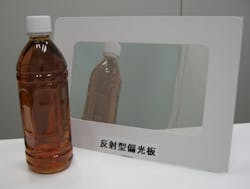Reflective polarizer for LCDs increases screen brightness by 50%
Tokyo, Japan--DuPont Teijin Films, Ltd. says it has developed the first reflective polarizer for use in liquid-crystal displays (LCDs). The plate is a combination of polymer and multilayer film technology, and recycles some of the rejected polarization back toward the viewer to increase light output.
As does a conventional polarizing plate for LCDs, the plate passes one linear polarization while rejecting the other. But rather than absorbing the rejected light, the plate reflects it backwards so that it hits a second layer, which upon re-reflection rotates the polarization of some of the light so that this time it passes through the polarizing plate. When compared to a standard polarizer, the result is a 50% increase in light output (for the same light input) or a 33% reduction in required power (for the same light output).
DuPont Teijin Films says that the new polarizer can be manufactured by only a slight modification of the company's facilities, without a large investment. The company's 2010 fiscal projection is for an LCD polarizer market of about 1 trillion yen (US $ 13.1 billion) within a few years; DuPont Teijin Films is aiming for LCD polarizer sales in fiscal 2015 of 10 billion yen (US $ 131 million).
The company is exhibiting its polarizer at FPD International, a flat-panel-display technology exhibition held at Pacifico Yokohama, Oct. 26-28, 2011 (Yokohama, Japan).
Sources:
http://www.teijin.co.jp/news/2011/jbd111025.html
http://techon.nikkeibp.co.jp/english/NEWS_EN/20111026/199819/

John Wallace | Senior Technical Editor (1998-2022)
John Wallace was with Laser Focus World for nearly 25 years, retiring in late June 2022. He obtained a bachelor's degree in mechanical engineering and physics at Rutgers University and a master's in optical engineering at the University of Rochester. Before becoming an editor, John worked as an engineer at RCA, Exxon, Eastman Kodak, and GCA Corporation.
